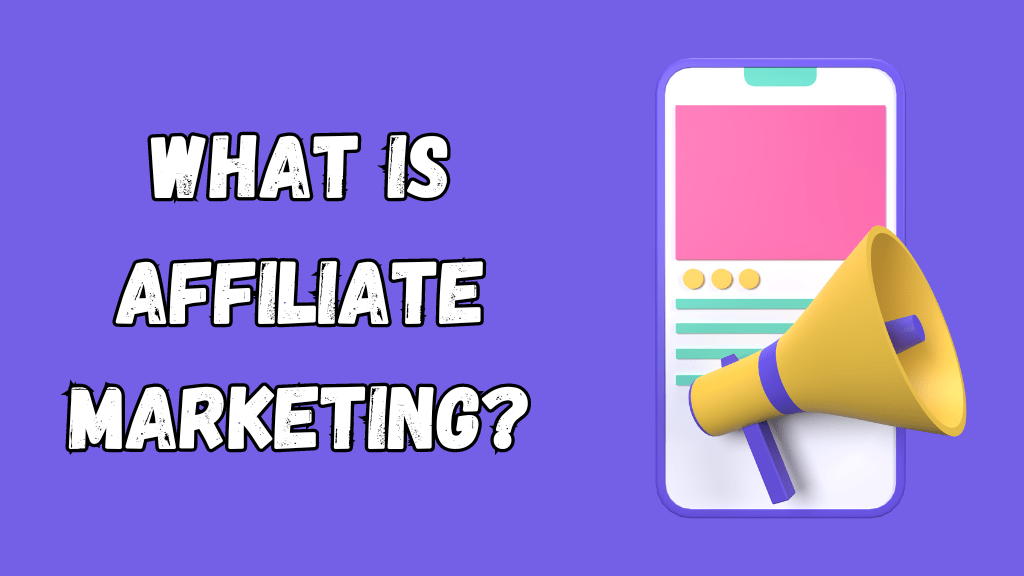A fantastic method of making extra money is through affiliate marketing. You have two options: either launch an affiliate program to market your own company or become an affiliate marketer and suggest other brands.
Affiliate marketing is advantageous for authors as well as brands. Brands gain access to new audiences and reliable recommendations from relevant creators. Affiliates and authors receive a commission in return for any sales or other marketing actions that come about as a result of the affiliate link.
You may learn how to become an affiliate marketer who promotes other products by following this comprehensive tutorial. We’ll cover how to get started with affiliate marketing, best practices to help you make more money, and online marketing pointers for creating an effective affiliate network.
Affiliate marketing: what is it?
By utilizing an affiliate link to promote a good or service offered by another merchant or advertiser, publishers can get paid a commission through the practice of affiliate marketing. When an affiliate partner helps the shop or advertiser achieve a particular goal, they are paid.
Affiliates are often compensated when a sale is made. However, there are affiliate marketing schemes that pay you for leads, trial users, website clicks, and app downloads.
A website that links influencers and creators to the affiliate programs of various brands is known as an affiliate network.
Joining many affiliate programs is free of cost. When used properly, an affiliate marketing plan can transform from side project into a successful online business concept that brings in passive revenue.
How affiliate marketing operates
In exchange for a commission on each sale, affiliate programs enable people or companies (affiliates) to market and sell a company’s goods or services. Every time a customer purchases something via the special affiliate link connected to their referral, the affiliate gets paid a commission.
This is the general operation of affiliate marketing:
- On their blog, social media account, or website, an affiliate posts a link or an advertisement for Store Z.
- The special affiliate link is clicked by a customer.
- In Store Z, the client purchases something.
- The affiliate network keeps track of the exchange.
- Store Z confirms receipt of the purchase.
- A financial commission is given to the affiliate.
Affiliate commission rates differ based on the business and the product. In the low end, you might get paid 5% of the sale, but in high ticket affiliate programs, you can make up to 50% with certain arrangements. Rather of offering a percentage on each transaction, some affiliate marketing schemes offer a flat amount.
3 types of affiliate marketing
There are several types of affiliate marketing, each with its own approach and characteristics. Here are three common types:
Pay-Per-Sale (PPS):
- This is the most prevalent type of affiliate marketing. In a PPS arrangement, the affiliate earns a commission when the referred customer makes a purchase. The commission can be a fixed amount or a percentage of the sale. Amazon Associates is a well-known example of a PPS affiliate program.
Pay-Per-Click (PPC):
- In a PPC affiliate program, affiliates earn a fee based on the number of clicks generated by their referral, regardless of whether the referred user makes a purchase. PPC is more focused on driving traffic to the merchant’s site rather than actual sales. Google AdSense is an example of a PPC affiliate program.
Pay-Per-Lead (PPL) or Cost-Per-Action (CPA):
- In a PPL or CPA affiliate program, affiliates earn a commission when their referral takes a specific action, such as filling out a form, signing up for a trial, or subscribing to a service. This model doesn’t necessarily require a direct sale to earn a commission. CPA programs are often used in industries where a direct sale might be a more extended process, such as in insurance or financial services.
Pros and cons of affiliate marketing
Pros of Affiliate Marketing:
- Low Entry Barrier:
- Affiliate marketing is accessible to almost anyone. You don’t need to create a product or service, handle customer service, or manage inventory. This makes it an attractive option for individuals and small businesses.
- Passive Income Potential:
- Once you’ve set up your affiliate links and created content, you can potentially earn passive income as long as your content remains relevant and continues to attract traffic.
- Diverse Monetization Opportunities:
- Affiliates can promote a wide range of products and services across various niches. This diversity allows you to explore different markets and find what works best for your audience.
- No Inventory or Customer Support:
- Affiliates don’t need to worry about storing inventory or providing customer support. These aspects are handled by the merchant, reducing the workload for affiliates.
- Cost-Effective:
- Affiliates can start with minimal upfront costs. You can create content using free or low-cost tools and platforms, making it a cost-effective way to start an online business.
- Global Reach:
- The internet provides a global audience for affiliates. You can reach people from around the world, expanding your potential customer base.
- Performance-Based Income:
- Affiliates are rewarded based on their performance. If you drive sales or leads, you earn commissions. This performance-based model can be motivating for affiliates.
Cons of Affiliate Marketing:
- Dependency on Merchant:
- Affiliates rely on the merchant’s reliability for tracking sales, providing accurate reporting, and timely payments. If the merchant fails in any of these aspects, it can affect the affiliate’s income.
- Variable Income:
- Affiliate income can be inconsistent, especially for beginners. It may take time to build a steady stream of income, and external factors such as changes in the market or search engine algorithms can impact earnings.
- High Competition:
- Popular niches can be highly competitive, making it challenging to stand out. Finding a unique angle or targeting a specific niche may be necessary for success.
- Dependence on Search Engine Rankings:
- If your affiliate marketing strategy heavily relies on organic traffic from search engines, changes in algorithms can affect your visibility and, subsequently, your income.
- Risk of Program Changes:
- Affiliate programs can change their terms, commission rates, or even shut down without much notice. This uncertainty poses a risk to affiliates, especially if they heavily rely on a single program.
- Ethical Concerns:
- Some affiliate marketers may engage in unethical practices, such as promoting low-quality products or using misleading tactics. This can lead to a negative reputation for the affiliate marketing industry as a whole.
- Overemphasis on Sales:
- Some affiliates may focus too much on making sales, potentially compromising the trust of their audience. Balancing promotional content with valuable, non-promotional content is crucial for long-term success.
While affiliate marketing offers numerous advantages, it’s essential to be aware of the challenges and navigate them strategically to build a sustainable and successful affiliate business.
How are profits made by affiliate marketers?
Income from affiliate marketing varies widely. Affiliate marketers range in income from a few hundred dollars per month to six figures annually. The more money you can make as an affiliate marketer, the bigger your following.
Based on more than 7,000 income profiles, compensation software provider Payscale claims that the average yearly wage of an affiliate marketer is over $55,000, with many making much more.
How to start affiliate marketing in 4 steps
Starting affiliate marketing involves several key steps. Here’s a simplified guide to help you get started in four main steps:
1. Choose a Niche:
- Select a niche that aligns with your interests, expertise, or passions. Choosing a niche that you are familiar with makes it easier to create engaging content and connect with your target audience.
2. Create a Platform:
- Set up a platform to promote affiliate products. This could be a blog, YouTube channel, podcast, or social media profiles. Choose a platform that aligns with your skills and where your target audience is likely to engage.
- Common platforms affiliate marketers use are:
- Blogging
- TikTok
- Pay per click (PPC)
- YouTube
3. Join Affiliate Programs:
- Research and join reputable affiliate programs within your chosen niche. Some well-known affiliate programs include Amazon Associates, ShareASale, and Commission Junction. Ensure the programs you choose offer products or services that are relevant to your audience.
4. Create Valuable Content and Promote Affiliate Products:
- Produce high-quality content that provides value to your audience. This can include product reviews, tutorials, comparison articles, or other content that addresses the needs and interests of your audience.
- Integrate your affiliate links naturally within your content. Avoid being overly promotional; instead, focus on how the recommended products or services can benefit your audience.
- Utilize various promotional channels such as social media, email marketing, or paid advertising to drive traffic to your affiliate content.
Bonus Tips:
- Disclose Your Affiliate Relationships: Be transparent with your audience by disclosing your affiliate partnerships. This builds trust and credibility.
- Track and Analyze Performance: Use analytics tools provided by affiliate programs or third-party tools to monitor the performance of your affiliate links. Analyze what works and adjust your strategy accordingly.
Remember, success in affiliate marketing takes time and consistency. Focus on building a relationship with your audience and providing valuable content. As you gain experience, you can refine your approach and explore additional strategies to enhance your affiliate marketing efforts.
Affiliate program examples
Certainly! Here are some examples of popular affiliate programs across various niches:
Amazon Associates:
- One of the largest and most well-known affiliate programs, Amazon Associates allows affiliates to promote a vast range of products available on the Amazon platform.
ShareASale:
- ShareASale is an affiliate marketing network that connects affiliates with a variety of merchants across different industries. It offers a diverse range of products and services.
CJ Affiliate (formerly Commission Junction):
- CJ Affiliate is a global affiliate marketing network that facilitates partnerships between affiliates and advertisers. It covers a wide array of industries, from retail to technology.
ClickBank:
- ClickBank is a digital marketplace that specializes in digital products such as e-books, online courses, and software. Affiliates can promote and earn commissions on a variety of digital offerings.
Rakuten Marketing:
- Rakuten Marketing, formerly known as Rakuten LinkShare, is an affiliate marketing platform with a broad range of merchants, offering products and services in various categories.
Bluehost Affiliate Program:
- Bluehost, a popular web hosting provider, has an affiliate program that allows individuals to earn commissions by promoting their hosting services.
ConvertKit Affiliate Program:
- ConvertKit, an email marketing platform, offers an affiliate program for those interested in promoting their services. Affiliates can earn commissions for successful referrals.
Shopify Affiliate Program:
- Shopify, an e-commerce platform, has an affiliate program that allows individuals to earn commissions by referring users who sign up for their services.
Booking.com Affiliate Partner Program:
- Booking.com offers an affiliate program for individuals interested in promoting hotel bookings. Affiliates earn commissions for each completed stay referred through their links.
Semrush Affiliate Program:
- Semrush, a digital marketing tool, has an affiliate program that allows affiliates to earn commissions by promoting their suite of SEO and marketing tools.
Before joining any affiliate program, it’s crucial to review their terms and conditions, commission structures, and payment processes. Choose programs that align with your niche and offer products or services relevant to your audience.


